Electrochemical Study of Clean and Pre-Corroded Reinforcements Embedded in Mortar Samples with Variable Amounts of Chloride Ions
Abstract
1. Introduction
2. Experimental Program
3. Results and Discussion
4. Conclusions
- All the rebars that have kept the corrosion products showed a very high icorr and a similar value, approximately 10 µA/cm2, regardless of the number of chlorides present in the specimen.
- Clean rebars (CLN) embedded in specimens with 0.6 Cl− remain with uncertain icorr (values between 0.1 and 1.0 µA/cm2).
- The values of the Ecorr measurement depended more on the amount of Cl− present in the specimen than on the passive or active state of the rebars.
- Only the predictions of the Ecorr and icorr coincided in bars embedded in specimens with at least a 0.8% Cl− by weight cement ratio, regardless of whether the rebar is clean or maintains the corrosion products.
- The low correlation of the results obtained in the Ecorr and icorr in different situations, makes it impossible to predict the passive or active state of the steel solely based on Ecorr measurements.
- To repair a concrete structure corroded by the effect of chloride ions, the concrete that surrounds the rebars must be removed so that all the corrosion products generated on the surface of the rebars can be eliminated. If the complete removal of the corrosion products is not achieved, even if a repair mortar is placed on it, the rebars will remain in active state.
Author Contributions
Funding
Institutional Review Board Statement
Informed Consent Statement
Data Availability Statement
Conflicts of Interest
References
- Slater, J.E. Corrosion of Metals in Association with Concrete; ASTM-STP: Philadelphia, PA, USA, 1983; Volume 818. [Google Scholar]
- Flis, J.; Pickering, H.W.; Osseo-Asare, K. Interpretation of Impedance Data for Reinforcing Steel in Alcaline Solutions Containing Chlorides and Acetates. Electrochim. Acta 1998, 43, 1921–1929. [Google Scholar] [CrossRef]
- Page, C.L. Mechanism of corrosion protection in reinforced concrete marine structures. Nature 1975, 258, 514–515. [Google Scholar] [CrossRef]
- Hope, B.B.; Page, J.A.; Ip, A.K.C. Corrosion rates of steel in concrete. Cem. Concr. Res. 1986, 16, 771–781. [Google Scholar] [CrossRef]
- Federal Highway Administration. 6 FHWA Research Engineer Wins Arthur S. Flemming Award Promoted Advanced Bridge Inspection Technologies; Federal Highway Administration: Washington, DC, USA, 2001. [Google Scholar]
- BRE Group. Report No 4; Building Research Establishment Ltd.: Watford, UK, 2001. [Google Scholar]
- Angst, U.M. Challenges and opportunities in corrosion of steel in concrete. Mater. Struct. 2018, 51, 4. [Google Scholar] [CrossRef]
- Pillai, R.G.; Trejo, D. Surface condition effects on critical chloride threshold of steel reinforcement. ACI Mater. J. 2005, 102, 103–109. [Google Scholar]
- Gancedo, J.R.; Alonso, C.; Andrade, C.; Gracia, M. AES study of the passive layer formed on iron in saturated Ca(OH)2 solutions. Corrosion 1989, 45, 976–977. [Google Scholar] [CrossRef]
- Torbati-Sarraf, H.; Poursaee, A. Corrosion of coupled steel with different microstructures in concrete environment. Constr. Build. Mater. 2018, 167, 680–687. [Google Scholar] [CrossRef]
- González, J.A.; Otero, E.; Feliú, S.; Bautista, A.; Ramírez, E.; Rodríguez, P.; López, W. Some considerations on the effect of chloride ion son the corrosion of Steel reinforcements embedded in concrete structures. Mag. Concr. Res. 1998, 50, 189–199. [Google Scholar] [CrossRef]
- Galán, I.; Andrade, C.; Castellote, M. Natural and accelerated CO2 binding Kinetics in cement paste at different relative humidity. Cem. Concr. Res. 2013, 49, 21–28. [Google Scholar] [CrossRef]
- Revert, A.B.; De Weerdt, K.; Hornbstel, K.; Geiker, M.R. Carbonation-induced corrosion: Investigation of the corrosion onset. Constr. Build. Mater. 2018, 162, 847–856. [Google Scholar] [CrossRef]
- Piqueras, M.A.; Company, R.; Jódar, L. Numerical analysis and computing of free boundary problems for concrete carbonation chemical corrosion. J. Comput. Appl. 2018, 336, 297–316. [Google Scholar] [CrossRef]
- Tristan Senga Kiesse, T.S.; Bonnet, S.; Amiri, O.; Ventura, A. Analysis of corrosion risk due to chloride diffusion for concrete structures in marine environment. Mar. Struct. 2020, 73, 102804. [Google Scholar] [CrossRef]
- Li, C.; Chen, Q.; Wang, R.; Wu, M.; Jiang, Z. Corrosion assessment of reinforced concrete structures exposed to chloride environments in underground tunnels: Theoretical insights and practical data interpretations. Cem. Concr. Compos. 2020, 112, 103652. [Google Scholar] [CrossRef]
- Angst, U.; Elsener, B.; Larsen, C.K.; Vennesland, O. Critical chloride content in reinforced concrete—A review. Cem. Concr. Res. 2009, 39, 1122–1138. [Google Scholar] [CrossRef]
- Wang, Y.; Liu, C.; Wang, Y.; Li, Q.; Liu, Z. Investigation on chloride threshold for reinforced concrete by a test method combining ANDT and ACMT. Constr. Build. Mater. 2019, 214, 158–168. [Google Scholar] [CrossRef]
- Page, C.L.; Lambert, P.; Vassie, P.R.W. Investigation of reinforcement corrosion: 1. The pore electrolyte phase in chloride-contaminated concrete. Mater. Struct. 1991, 24, 243–252. [Google Scholar] [CrossRef]
- Lambert, P.; Page, C.L.; Vassie, P.R.W. Investigation of reinforcement corrosion: 2. Electrochemical monitoring of steel in chloride-contaminated concrete. Mater. Struct. 1991, 24, 351–358. [Google Scholar] [CrossRef]
- Oh, B.H.; Jang, S.Y.; Shin, Y.S. Experimental investigation of the threshold chloride concentration for corrosion initiation in reinforced concrete structures. Mag. Concr. Res. 2003, 55, 117–124. [Google Scholar] [CrossRef]
- Kayyali, O.A.; Haque, M.N. The ratio of Cl-/OH- in chloride contaminated concrete. A most important criterion. Mag. Concr. Res. 1995, 47, 235–242. [Google Scholar] [CrossRef]
- Ann, K.T.; Song, H.W. Chloride threshold level for corrosion of steel in concrete. Corros. Sci. 2007, 49, 4113–4133. [Google Scholar] [CrossRef]
- Haussman, D.A. Steel corrosion in concrete; How does it occur? Mater. Prot. 1967, 6, 19–23. [Google Scholar]
- Rossi, E.; Polder, R.; Copuroglu, O.; Nigland, T.; Savija, B. The influence of defects at the steel/concrete interface for chloride-induced pitting corrosion of naturally deteriorated 20 years old specimens studied through X-ray Computed Tomography. Constr. Build. Mater. 2020, 235, 117474. [Google Scholar] [CrossRef]
- Shi, J.; Ming, J. Influence of defects at the steel-mortar interface on the corrosion behavior of steel. Constr. Build. Mater. 2017, 136, 118–125. [Google Scholar] [CrossRef]
- Soylev, T.A.; Francois, R. Quality of steel-concrete interface and corrosion of reinforcing steel. Cem. Concr. Res. 2003, 33, 1407–1415. [Google Scholar] [CrossRef]
- Mohammed, T.U.; Otsuki, N.; Hamada, H.; Yamaji, T. Chloride-induced corrosion of steel bars in concrete with presence of gap at steel-concrete interface. ACI Mater. J. 2002, 99, 149–156. [Google Scholar]
- Kenny, A.; Katz, A. Steel-concrete interface influence on chloride threshold for corrosion–Empirical reinforcement to theory. Constr. Build. Mater. 2020, 244, 118376. [Google Scholar] [CrossRef]
- Alhozaimy, A.; Hussain, R.R.; Al-Negheimish, A. Electro-chemical investigation for the effect of rebar source and surface condition on the corrosion rate of reinforced concrete structures under varying corrosive environments. Constr. Build. Mater. 2020, 244, 118317. [Google Scholar] [CrossRef]
- Duracrete. General Guidelines for Durability Design and Redesign; CUR: Gouda, Belgium, 2000. [Google Scholar]
- de Fomento, M. Instrucción de Hormigón Estructural EHE-08; Madrid, Spain, 2008. Available online: https://www.mitma.gob.es/recursos_mfom/1820100.pdf (accessed on 20 October 2021).
- American Concrete Institute. ACI 318-19 Building Code Requirements for Structural Concrete and Commentary; American Concrete Institute: Farmington Hills, MI, USA, 2019. [Google Scholar]
- Ožbolt, J.; Balabanic, G.; Kušter, M. 3D Numerical modelling of steel corrosion in concrete structures. Corros. Sci. 2011, 53, 4166–4177. [Google Scholar] [CrossRef]
- Chauhan, A.; Sharma, U.K. Crack propagation in reinforced concrete exposed to non-uniform corrosion under real climate. Eng. Fract. Mech. 2021, 248, 107719. [Google Scholar] [CrossRef]
- Chen, J.; Zhang, W.; Tang, Z.; Huang, Q. Experimental and numerical investigation of chloride-induced reinforcement corrosion and mortar cover cracking. Cem. Concr. Compos. 2020, 111, 103620. [Google Scholar] [CrossRef]
- Xu, F.; Xiao, Y.; Wang, S.; Li, W.; Liu, W.; Du, D. Numerical model for corrosion rate of steel reinforcement in cracked reinforced concrete structure. Constr. Build. Mater. 2018, 180, 55–67. [Google Scholar] [CrossRef]
- Fekak, F.E.; Garibaldi, L.; Elkhalfi, A.; Alami, E.E. A numerical study of pitting corrosion in reinforced concrete structures. J. Build. Eng. 2021, 43, 102789. [Google Scholar]
- ASTM C876-09 Standard. Standard Test Method for Half-Cell Potentials of Uncoated Reinforcing Steel in Concrete; ASTM International: West Conshohocken, PA, USA, 2009. [Google Scholar] [CrossRef]
- Videm, K. Corrosion of Reinforcement in Concrete. Monitoring, Prevention and Rehabilitation. (EFC 25); RC Press: London, UK, 1998; Chapter 10; pp. 104–121. [Google Scholar]
- Ismail, M.; Ohtsu, M. Corrosion rate of ordinary and high-performance concrete subjected to chloride attack by AC impedance spectroscopy. Constr. Build. Mater. 2006, 20, 458–469. [Google Scholar] [CrossRef]
- Reou, J.S.; Ann, K.Y. Electrochemical assessment on the corrosion risk of steel embedment in OPC concrete depending on the corrosion detection techniques. Mater. Chem. Phys. 2009, 113, 78–84. [Google Scholar] [CrossRef]
- Andrade, C.; Keddam, M.; Nóvoa, X.R.; Pérez, M.C.; Rangel, C.M.; Takenouti, H. Electrochemical behavior of steel rebars in concrete: Influence of environmental factors and cement chemistry. Electrochim. Acta 2001, 46, 3905–3912. [Google Scholar] [CrossRef]
- González, J.A.; Miranda, J.M.; Feliú, S. Considerations on reproducibility of potential and corrosion rate measurements in reinforced concrete. Corros. Sci. 2004, 46, 2467–2485. [Google Scholar] [CrossRef]
- Sagües, A. Corrosion Measurement Techniques for Steel in Concrete. In Corrosion-National Association of Corrosion Engineers Annual Conference; NACE: Houston, TX, USA, 1993. [Google Scholar]
- Ministerio de la Presidencia. RC-16, Instrucción para la Recepción de Cementos; Boletín Oficial del Estado: Madrid, Spain, 2016. [Google Scholar]
- Stern, M.; Geary, A.L. Electrochemical polarization I. A theoretical analysis of the shape of the polarization curves. J. Electrochem. Soc. 1957, 104, 56–63. [Google Scholar] [CrossRef]
- Bastidas, D.M.; González, J.A.; Feliú, S.; Cobo, A.; Miranda, J.M. A quantitative study of concrete-embedded steel corrosion using potentiostatic pulses. Corrosion 2007, 63, 1094–1100. [Google Scholar] [CrossRef]
- Prieto, M.I.; Cobo, A.; Rodríguez, A.; González, M.N. The efficiency of surface-applied corrosion inhibitors as a method for the repassivation of corroded reinforcement bars embedded in ladle furnace slag mortars. Constr. Build. Mater. 2014, 54, 70–77. [Google Scholar] [CrossRef][Green Version]
- Browne, R.D.; Geoghegan, M.P.; Baker, A.F. Corrosion Monitoring of Steel in Concrete. In Corrosion of Reinforcement in Concrete Construction; Crane, A.P., Ed.; Ellis Horwood Ltd.: Chichester, UK, 1983; Chapter 13; pp. 193–222. [Google Scholar]
- Elsener, B.; Andrade, C.; Gulikers, J.; Polder, R.; Raupach, M. Half-cell potential measurements—Potential mapping on reinforced concrete structures. Mater. Struct. 2003, 36, 1–11. [Google Scholar] [CrossRef]
- Andrade, C.; Alonso, C. Test methods for on-site corrosion rate measurements of steel reinforcement in concrete by means of the polarization resistance method. Mater. Struct. 2004, 37, 623–643. [Google Scholar] [CrossRef]
- Network, D. Manual de Inspección, Evaluación y Diagnóstico de Corrosión en Estructuras de Hormigón Armado; CYTED Programe: Rio de Janeiro, Brazil, 1998; ISBN 980-296-541-3. [Google Scholar]
- Eurocode 2: Design of Concrete Structures—Part 1-1: General Rules and Rules for Buildings; CEN: Brussels, Belgium, 2004.
- Prieto, M.I.; Cobo, A.; Rodríguez, A.; Calderón, V. Corrosion behavior of reinforcements bars embedded in mortar specimens containing ladle furnace slag in partial substitution of aggregate and cement. Constr. Build. Mater. 2013, 38, 188–194. [Google Scholar] [CrossRef]
- Martinez, M.J.; Lopez, M.; Cantero, D.; Rodríguez, J. Influence of the previous state of corrosion of rebars in predicting the service life of reinforced concrete structures. Constr. Build. Mater. 2018, 188, 915–923. [Google Scholar] [CrossRef]
- Miranda, J.M.; González, J.A.; Cobo, A.; Otero, E. Several question about electrochemical rehabilitation methods for reinforced concrete structures. Corros. Sci. 2006, 48, 2172–2188. [Google Scholar] [CrossRef]
- Macdonald, D.D.; Qiu, J.; Zhu, Y.; Yang, J.; Engelhardt, G.R.; Sagüés, A. Corrosion of rebar in concrete. Part I: Calculation of the corrosion potential in the passive state. Corros. Sci. 2020, 177, 109018. [Google Scholar] [CrossRef]
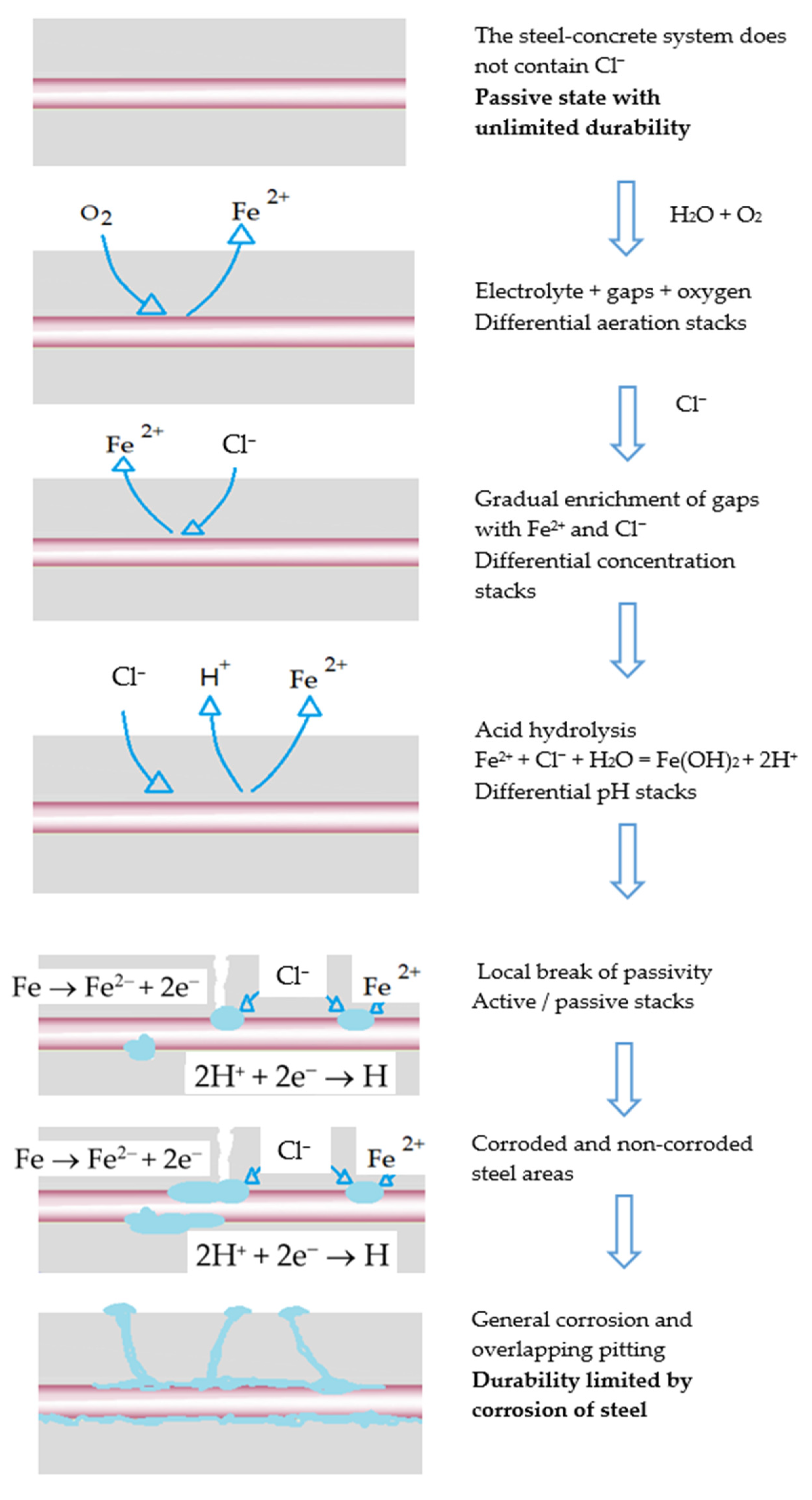

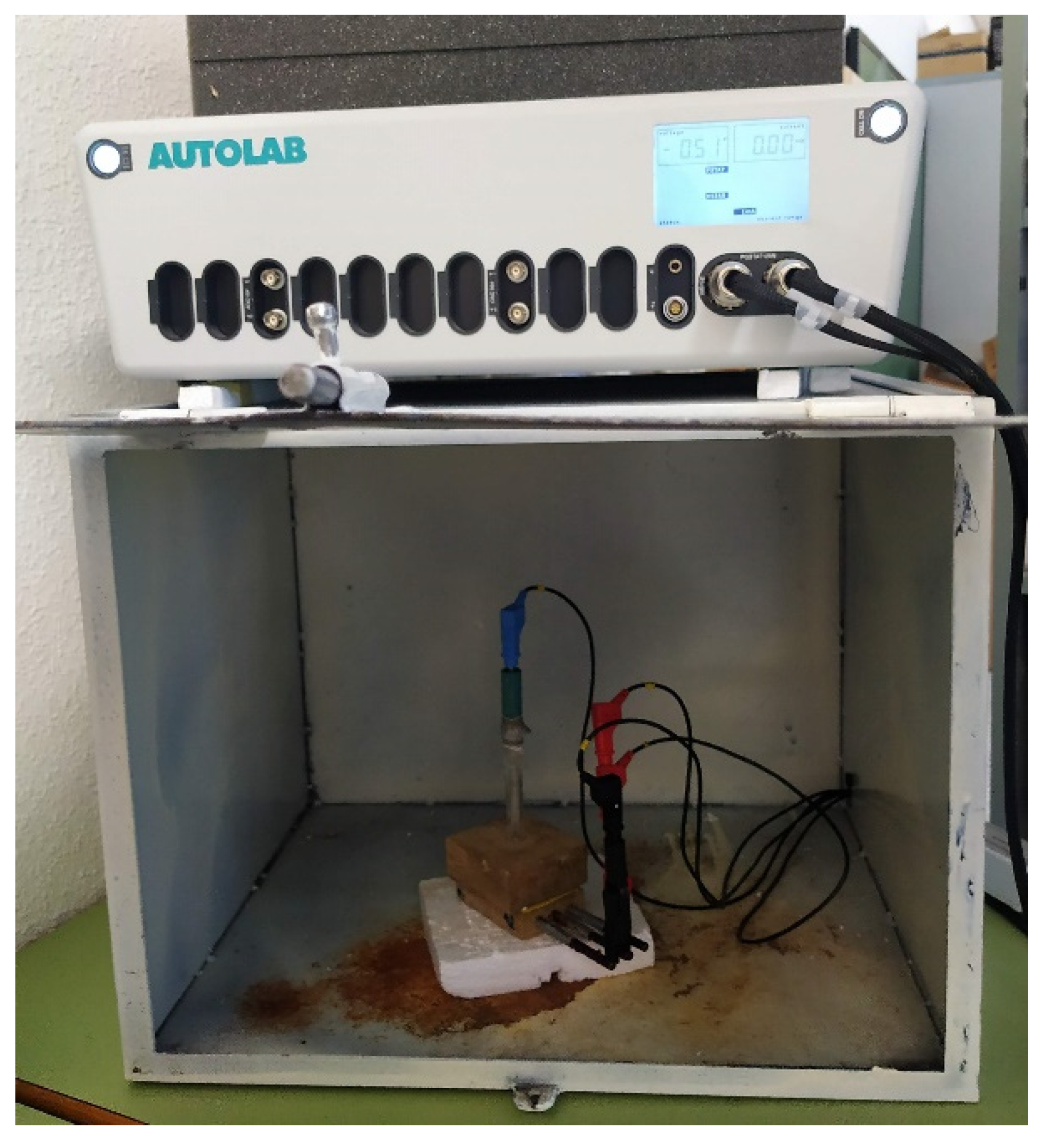
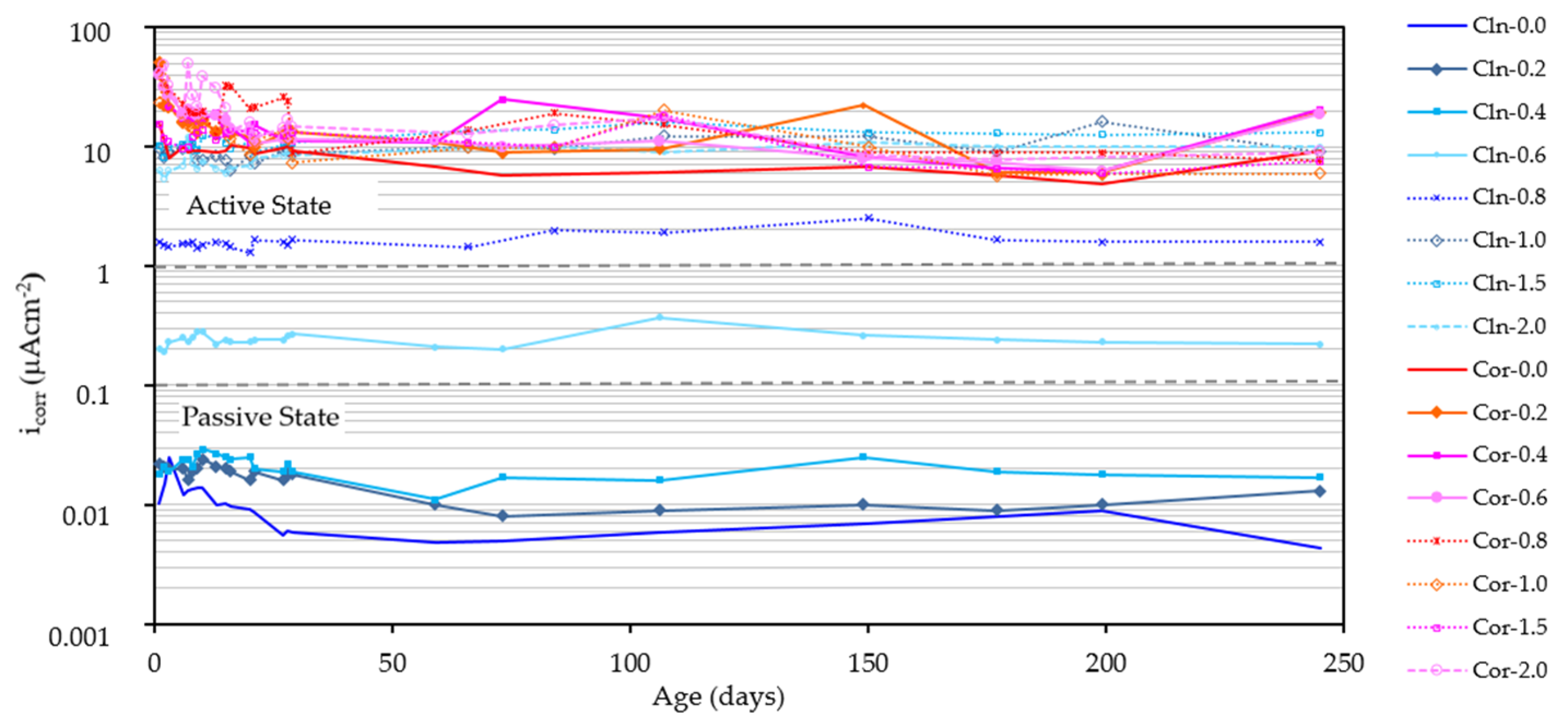
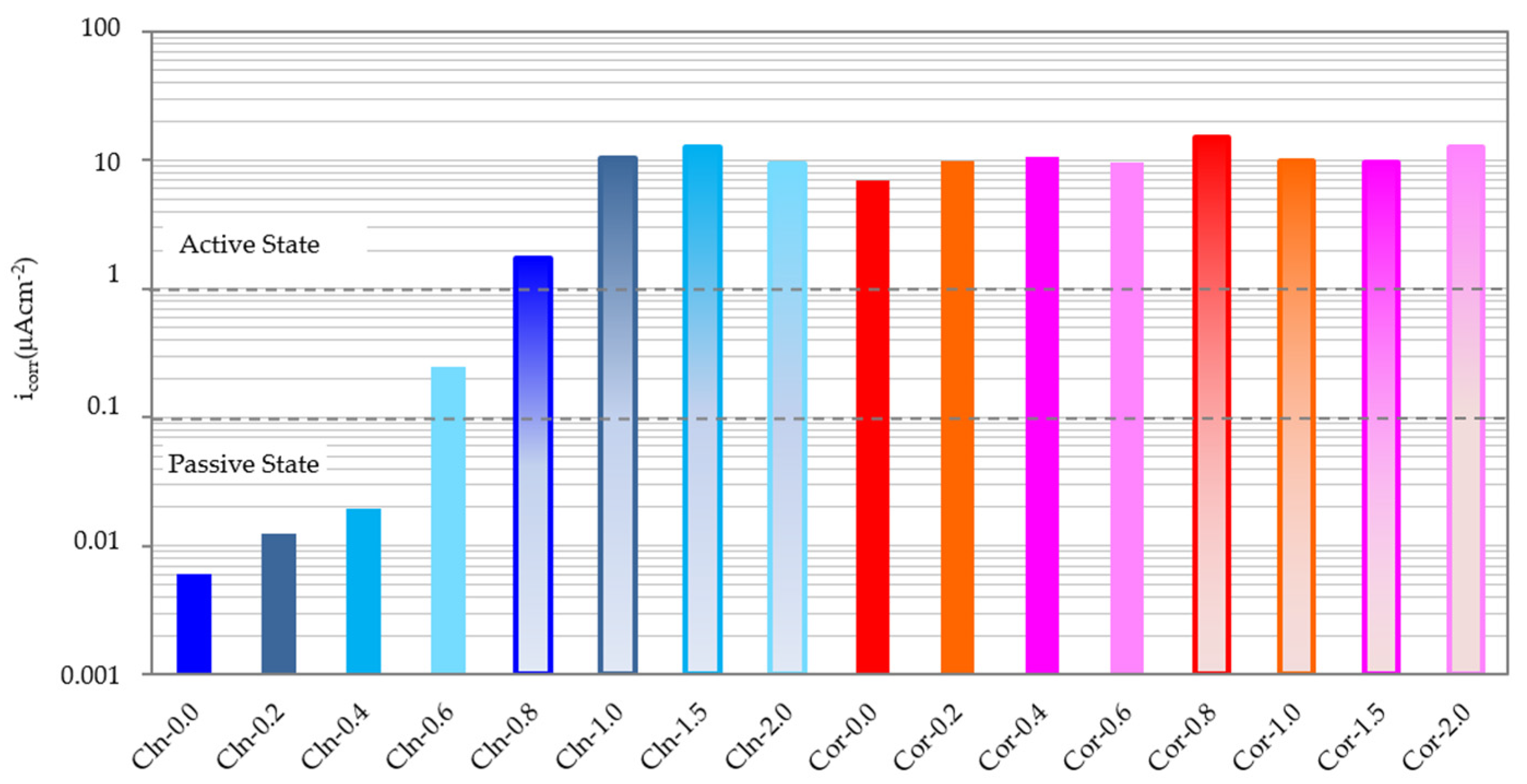

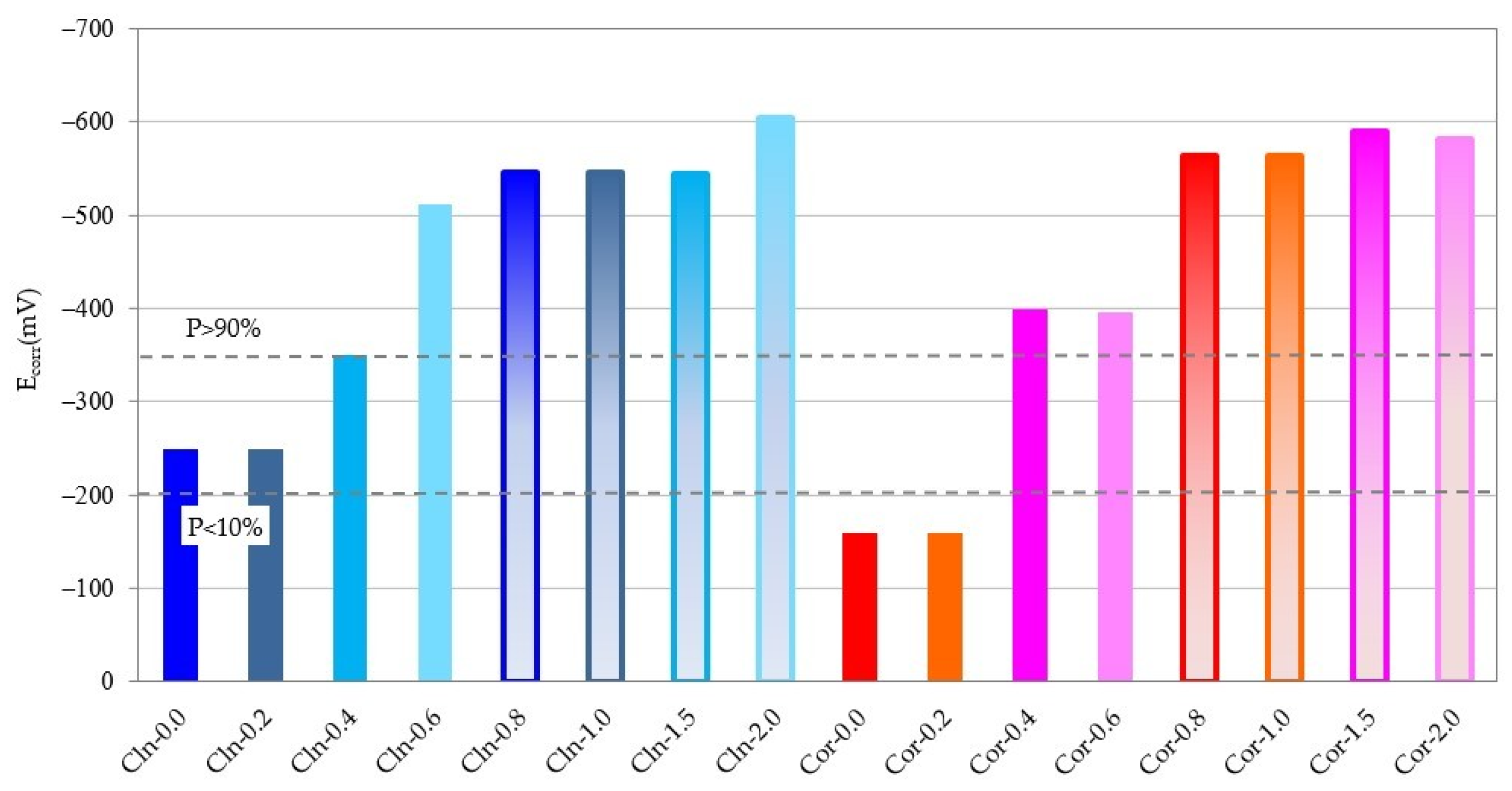
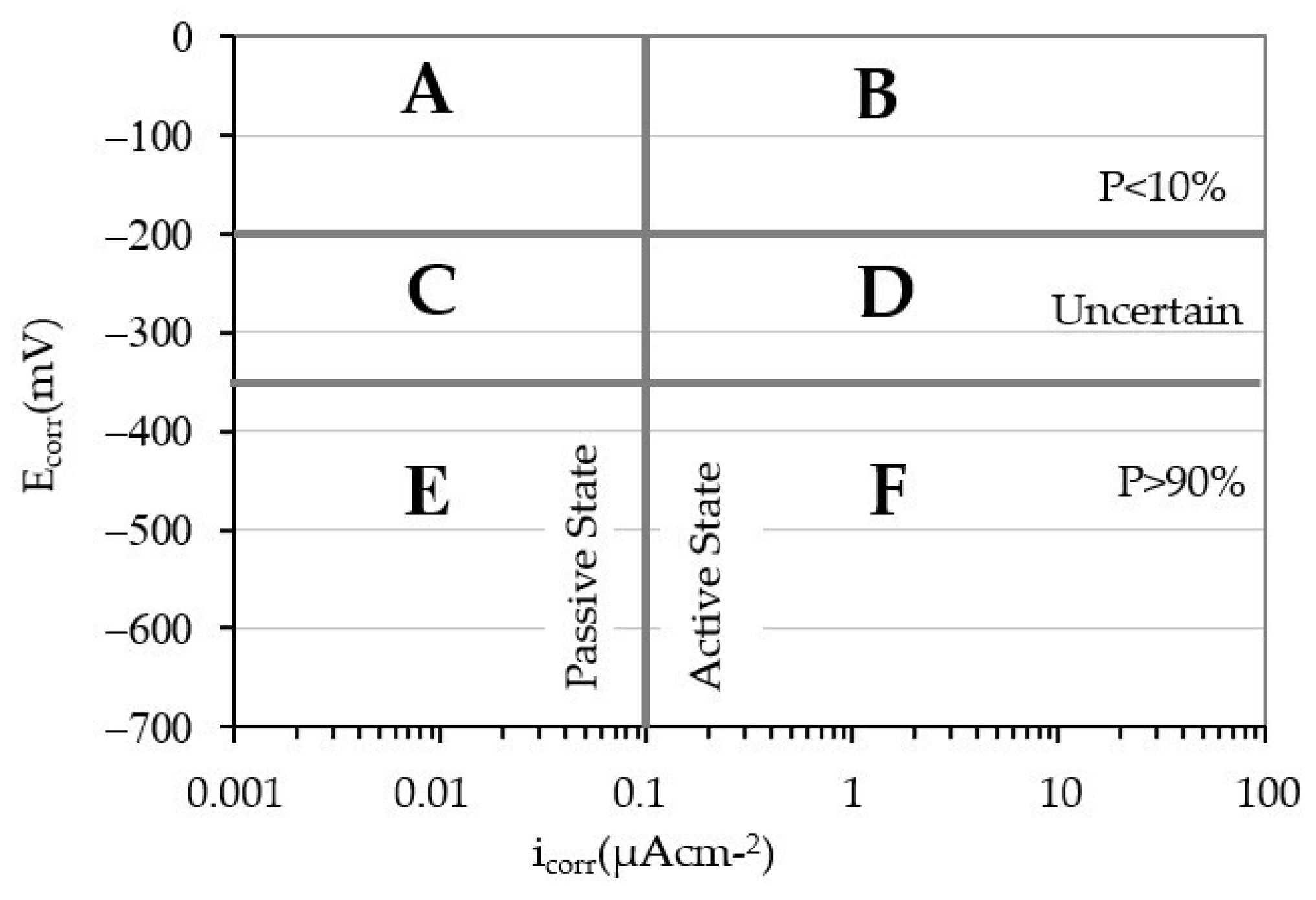
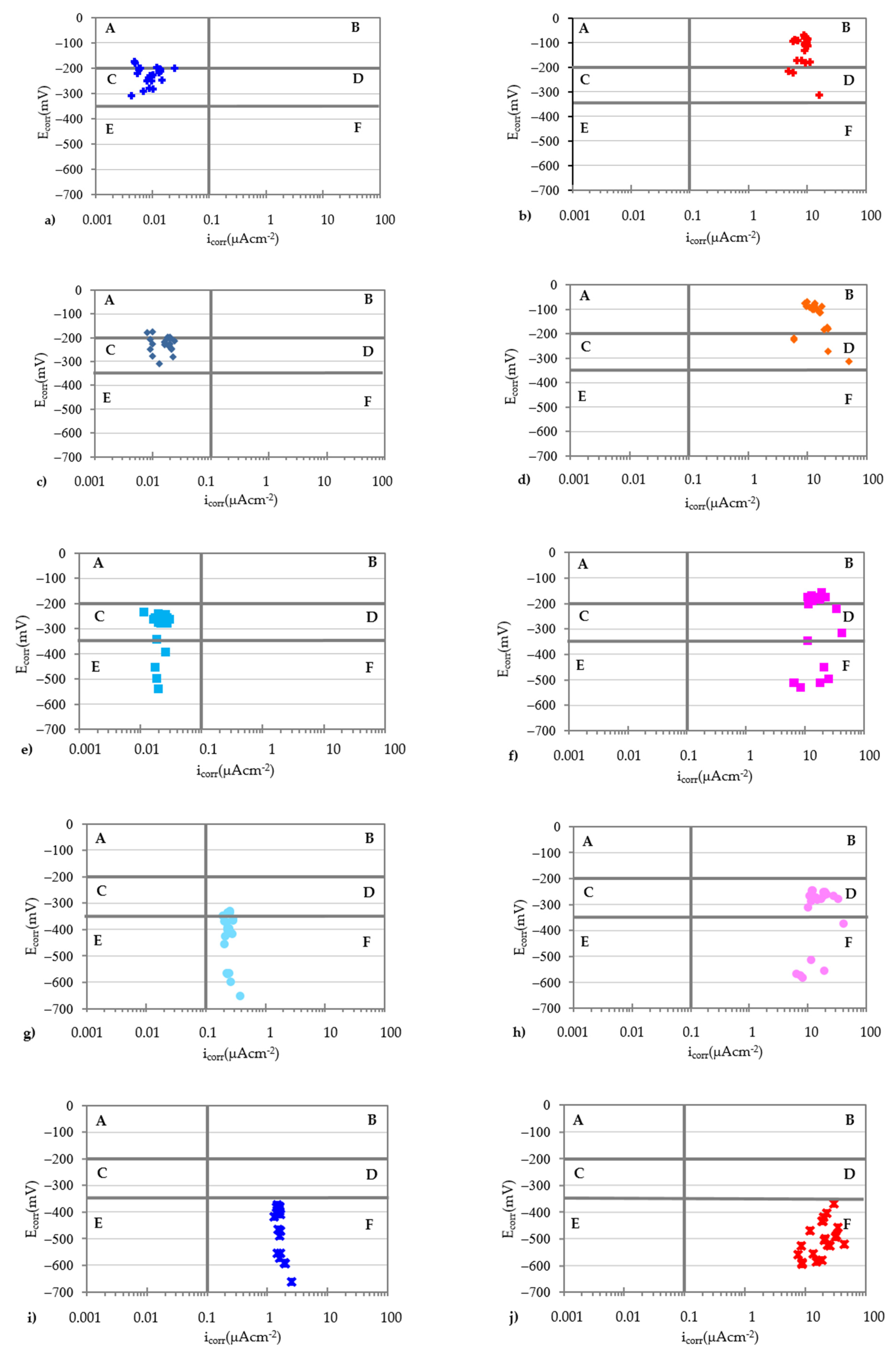
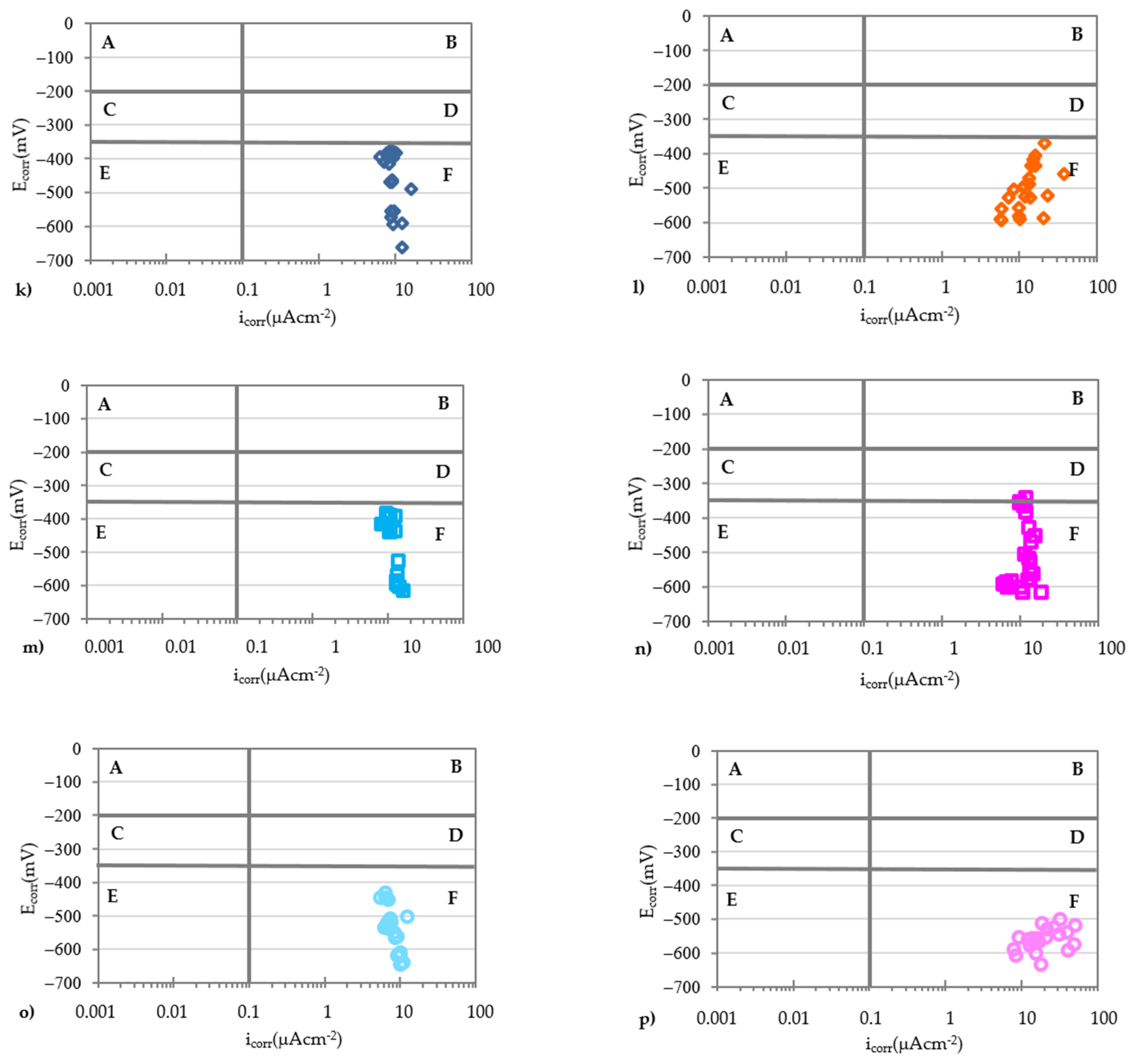
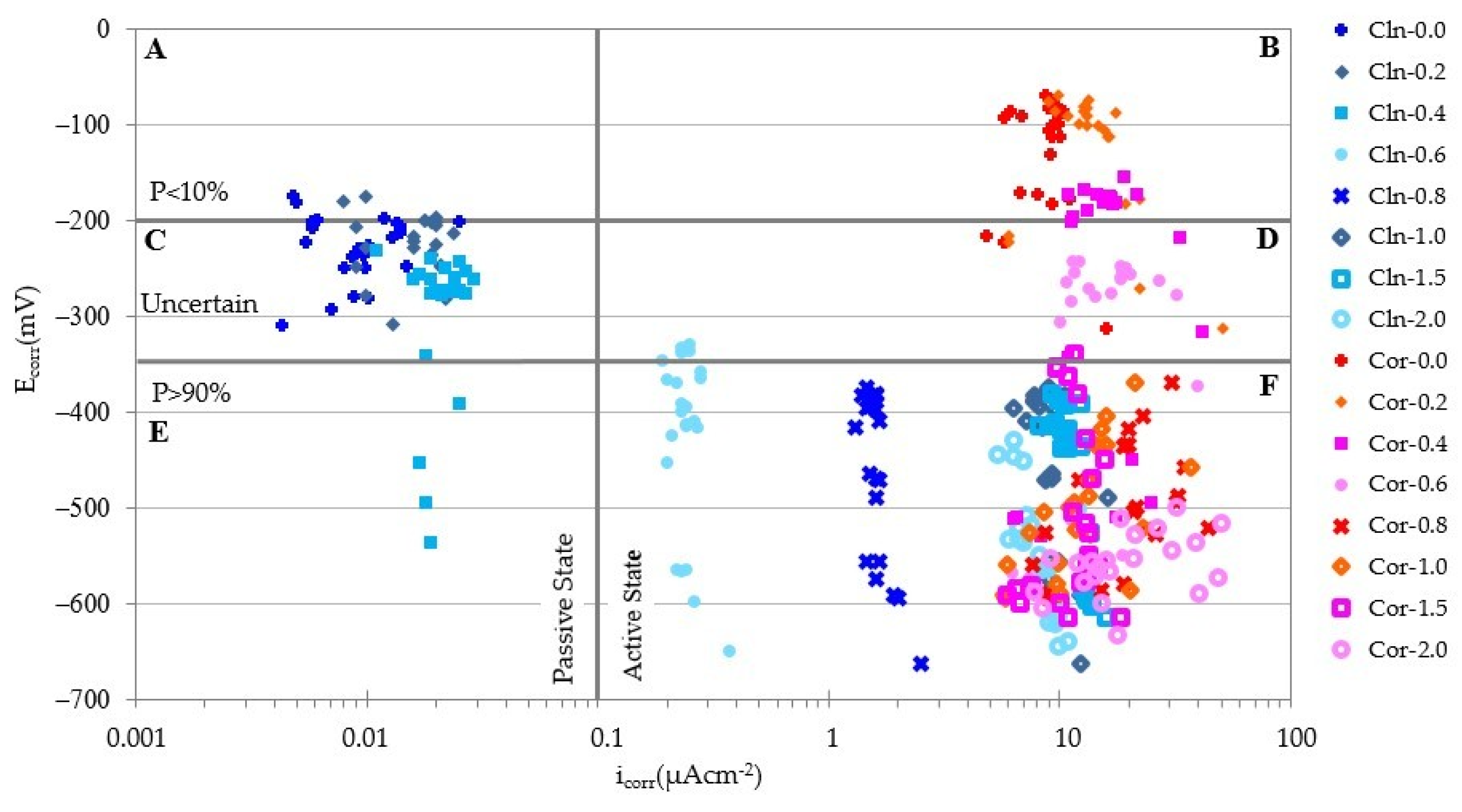
| Element | C | Si | Mn | P | S | Cr | Ni | Cu | Mo |
|---|---|---|---|---|---|---|---|---|---|
| Composition (%) | 0.21 | 0.22 | 0.72 | <0.01 | 0.022 | 0.05 | 0.09 | 0.08 | <0.05 |
| Physical Characteristics | Chemical Composition | |||
|---|---|---|---|---|
| Cement | Blaine specific surface area | 414 m2/kg | SO3 | 3.40% |
| Density | 3.15 g/cm3 | Cl− | 0.01% | |
| Initial setting time | 108 min | Calcination loss | 1.72% | |
| Final setting time | 160 min | Insoluble residue | 0.40% | |
| Sand | Sand equivalent | 78 | S, SO3, Cl− and low specific | |
| Real density | 2.619 g/cm3 | weight particles | 0.00% | |
| Normal absorption coefficient | 15% | Fine | 0.78% | |
| Saturated surface dry density | 2.630 g/cm3 | |||
| Clay clumps | 0.01% | |||
| Coefficient of type of course aggregate | 0.26% | |||
| Soft particles | 0.93% | |||
| Measurement | Risk | Values |
|---|---|---|
| Ecorr (mV) | High >90% | Ecorr < −350 |
| Uncertainty | −350 < Ecorr < −200 | |
| Low <10% | Ecorr > −200 | |
| icorr (μA/cm2) | Active state | icorr > 1μA/cm2 |
| High corrosion | 0.5 μA/cm2 < icorr < 1 μA/cm2 | |
| Low corrosion | 0.1 μA/cm2 < icorr < 0.5 μA/cm2 | |
| Passive state | icorr < 0.1 μA/cm2 |
Publisher’s Note: MDPI stays neutral with regard to jurisdictional claims in published maps and institutional affiliations. |
© 2021 by the authors. Licensee MDPI, Basel, Switzerland. This article is an open access article distributed under the terms and conditions of the Creative Commons Attribution (CC BY) license (https://creativecommons.org/licenses/by/4.0/).
Share and Cite
González, M.d.l.N.; Prieto, M.I.; Cobo, A.; Olmedo, F.I. Electrochemical Study of Clean and Pre-Corroded Reinforcements Embedded in Mortar Samples with Variable Amounts of Chloride Ions. Materials 2021, 14, 6883. https://doi.org/10.3390/ma14226883
González MdlN, Prieto MI, Cobo A, Olmedo FI. Electrochemical Study of Clean and Pre-Corroded Reinforcements Embedded in Mortar Samples with Variable Amounts of Chloride Ions. Materials. 2021; 14(22):6883. https://doi.org/10.3390/ma14226883
Chicago/Turabian StyleGonzález, María de las Nieves, María Isabel Prieto, Alfonso Cobo, and Fernando Israel Olmedo. 2021. "Electrochemical Study of Clean and Pre-Corroded Reinforcements Embedded in Mortar Samples with Variable Amounts of Chloride Ions" Materials 14, no. 22: 6883. https://doi.org/10.3390/ma14226883
APA StyleGonzález, M. d. l. N., Prieto, M. I., Cobo, A., & Olmedo, F. I. (2021). Electrochemical Study of Clean and Pre-Corroded Reinforcements Embedded in Mortar Samples with Variable Amounts of Chloride Ions. Materials, 14(22), 6883. https://doi.org/10.3390/ma14226883







